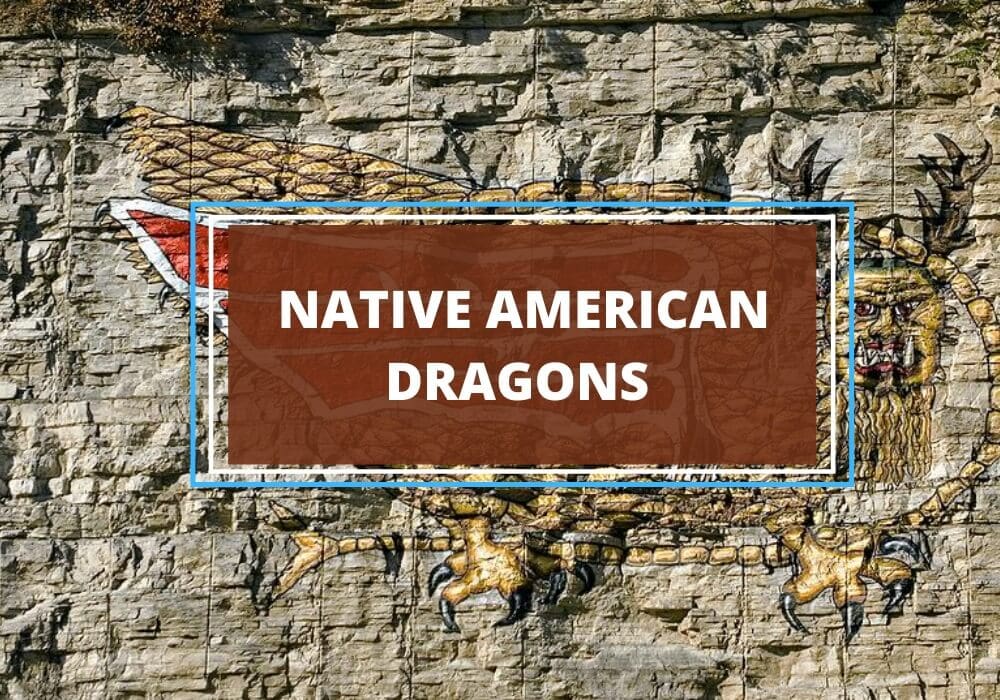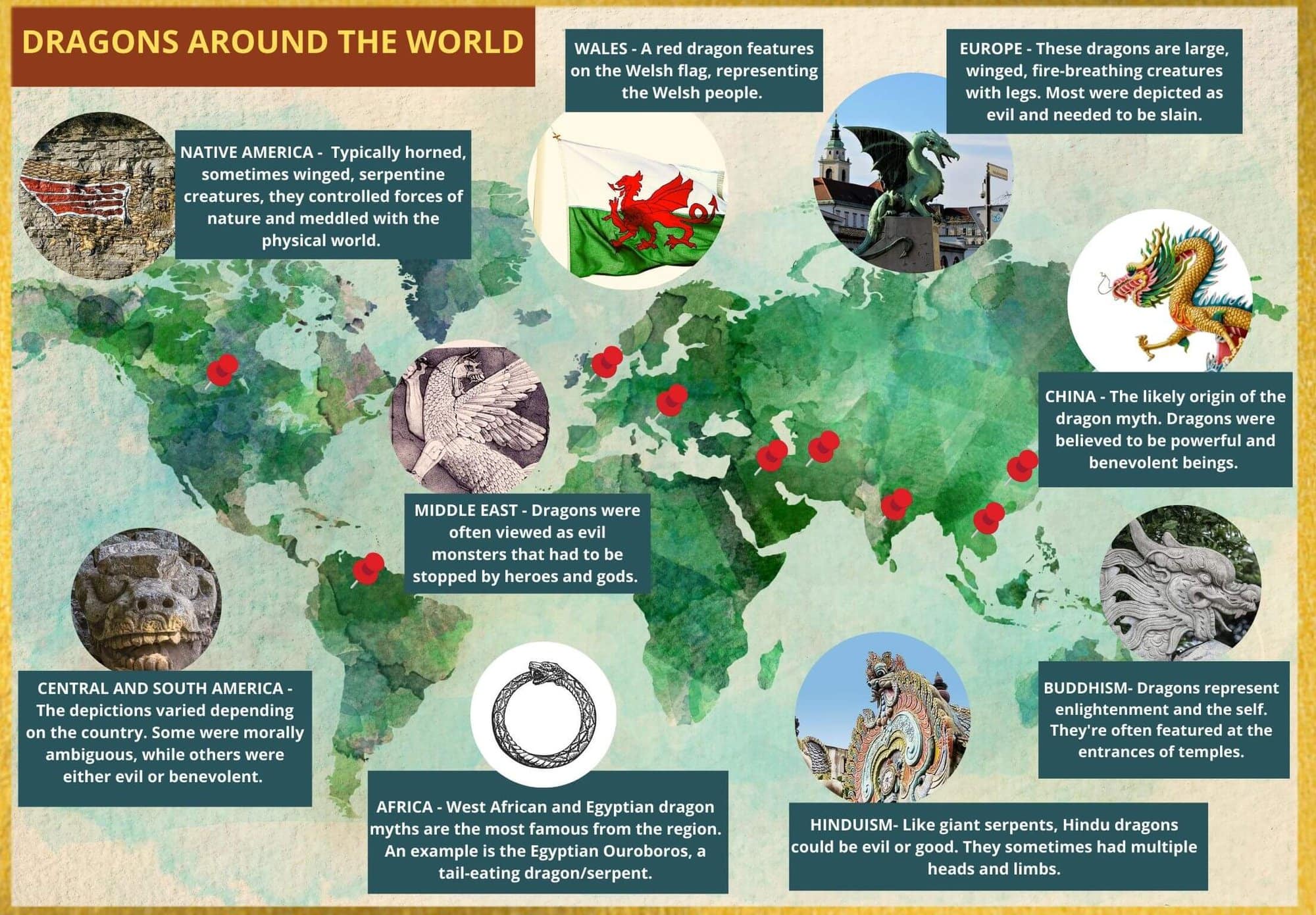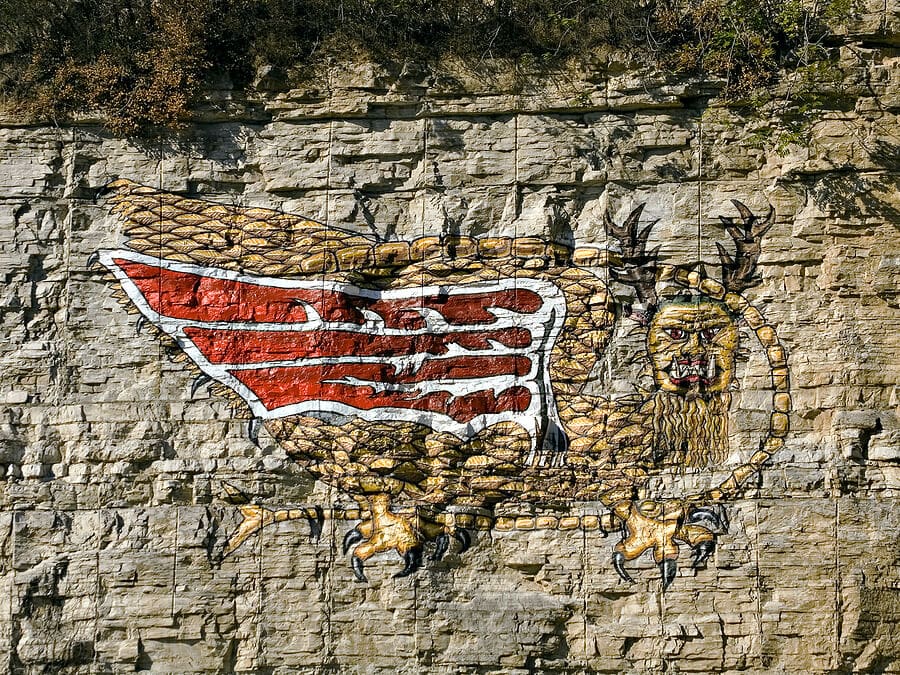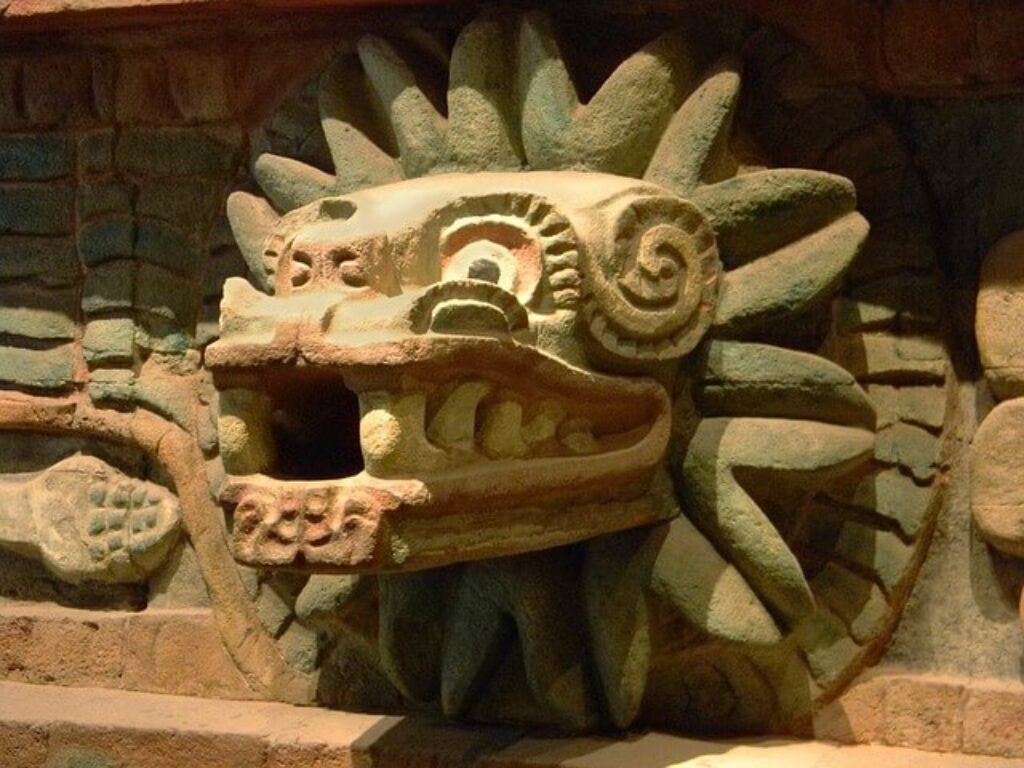
Table of Contents
The dragon myths of the North and South Americas aren’t as famous worldwide as those of Europe and Asia. However, they are as colorful and fascinating as they were widespread among the native tribes of the two continents. Let’s take a look at the unique dragons of North and South American mythology.

North American Dragons
When people think of the mythical creatures worshipped and feared by the native tribes of North America, they usually imagine spirits of bears, wolves, and eagles. However, the myths and legends of most North American native tribes also include a lot of giant serpents and dragon-like creatures that were often very significant to their customs and practices.
Physical Appearance of the Native North American Dragons
The various dragons and serpents in the myths of the native North American tribes come in all shapes and sizes. Some were enormous sea serpents with or without any legs. Many were giant land serpents or reptiles, typically dwelling in caves or the bowels of the North American mountains. And then some were flying cosmic serpents or winged cat-like beasts with scales and reptilian tails.

The famous Piasa or Piasa Bird dragon, for example, was depicted on the limestone bluffs in Madison County as having feathery wings with bat-like claws, golden scales all over its body, elk’s horns on its head, and a long spiked tail. It certainly doesn’t look like the European or Asian dragons most people know, but it can definitely be classified as a dragon nevertheless.
Another example is the underwater panther dragon from the Great Lakes region which had a cat-like body but was drawn with scales, a reptilian tail, and two bull’s horns on its head.
Then, there are the many giant sea or cosmic serpent myths that are usually depicted with snake-like bodies.
- Kinepeikwa or Msi-Kinepeikwa was a massive land serpent that gradually grew by repeatedly shedding its skin until it eventually dove into a lake.
- Stvkwvnaya was a horned sea serpent from Seminole mythology. Its horn was rumored to be a powerful aphrodisiac, so the natives often tried to chant and perform magical summons to draw the serpent and harvest its horn.
- Gaasyendietha is another interesting creature as it was described more like the European dragons even though settlers from Europe hadn’t arrived in North America yet. Gaasyendietha was famous in Seneca mythology and while it lived in rivers and lakes, it also flew in the sky with its giant body and it used to spew fire.
There were also depictions of winged rattlesnakes in some Mississippian ceramics and other artifacts.
In short, the dragon myths of North America were very similar to dragons from all over the rest of the world.
Origins of the North American Dragon Myths
There are two or three possible sources of the North American dragon myths and it’s likely that they all came into play when these myths were created:
- Many historians believe that the North American dragon myths were brought with the people as they migrated from East Asia through Alaska. This is very likely as many of the North American dragons do resemble East Asian dragon myths.
- Others believe that the dragon myths of native North American tribes were their own inventions as they did spend a lot of time on the continent alone between their migration and the European colonization.
- There’s also a third hypothesis which is that some dragon myths, particularly on the east North American coast, were brought by the Nordic vikings of Leif Erikson and other explorers around the 10th century AD. This is a much less likely but still possible hypothesis.
In essence, it’s very possible that all three of these origins played a part in the formation of the different North American dragon myths.
Meaning and Symbolism Behind Most North American Dragon Myths
The meanings behind the different North American dragon myths are as diverse as the dragons themselves. Some were benevolent or morally-ambiguous sea creatures and water spirits like the East Asian dragons.
The feathered sea serpent Kolowissi from Zuni and Hopi mythology, for example, was the chief spirit of a group of water and rain spirits called Kokko. It was a horned serpent but it could transform into any shape it wanted to, including human form. It was both worshipped and feared by the natives.
Many other dragon myths were described as exclusively malevolent. Many sea serpents and land drakes alike used to abduct children, spit poison or fire, and were used as bogeys to scare children away from certain areas. The Oregon sea serpent Amhuluk and the Huron drake Angont are good examples of that.
South and Central American Dragons
South and Central American dragon myths are even more diverse and colorful than those in North America. They are also unique from most other dragon myths across the world in that many of them were covered with feathers. Another interesting feature is that many of these Mesoamerican, Caribbean, and South American dragons were also prominent gods in the natives’ religions and not just monsters or spirits.
Physical Appearance of the Native South and Central American Dragons
The many dragon deities of the Mesoamerican and South American cultures had truly unique physical properties. Many were types of shapeshifters and could transform into human forms or other beasts.
In their “standard” dragon-like or serpent forms, they often had chimera-like or hybrid characteristics as they had additional animal heads and other body parts. Most famously, however, most of them were covered with colorful feathers, sometimes with scales as well. This is likely due to most South American and Mesoamerican cultures living in dense jungle regions where colorful tropical birds could be frequently seen.
Origins of the South and Central American Dragon Myths
A lot of people draw a connection between the colorful appearances of South American and East Asian dragons and mythological serpents and connect that to the fact that the native American tribes traveled to the New World from East Asia through Alaska.
These connections are likely coincidental, however, as the dragons of South and Mesoamerica tend to be very different from those in East Asia upon a more thorough inspection. For one, dragons in East Asia were predominantly scaly water spirits, where the dragons of South and Central America are feathery and fiery gods that are only occasionally connected to rainfall or water worship, like the Amaru.
It is still possible that these dragons and serpents were at least inspired by or based on old East Asian myths but they do seem sufficiently different to be considered their own thing. Unlike North American natives, the Central and South American tribes had to travel much further, longer, and to drastically different regions so it’s natural that their myths and legends changed more than those of the North American natives.
Meaning and Symbolism Behind Most South and Central American Dragon Myths
The meaning of most South and Central American dragons differs a lot depending on the particular dragon deity. Most of the time, however, they were actual gods and not just spirits or monsters.
Many of them were the “main” deities in their respective pantheons or were gods of rainfall, fire, war, or fertility. As such, the majority of them were considered good or at least morally ambiguous, even though most of them did require human sacrifices.
- Quetzalcoatl
Probably the most famous example is the Aztec and Toltec father god Quetzalcoatl (also known as Kukulkan by the Yucatec Maya, Qʼuqʼumatz by the K’iche’ Maya, as well as Ehecatl or Gukumatz in other cultures).

Quetzalcoatl was an amphiptere dragon, meaning that he had two wings and no other limbs. He had both feathers and multi-colored scales, and he could also transform into a human man whenever he wanted. He could also transform into the sun and solar eclipses were said to be the Earth Serpent swallowing Quetzalcoatl temporarily.
Quetzalcoatl, or Kukulkan, was also unique in that he was the only deity that didn’t want or accept human sacrifices. There are many myths about Quetzalcoatl arguing and even fighting with other gods such as the war god Tezcatlipoca, but he lost those arguments and human sacrifices continued.
Quetzalcoatl was also a god of a great many things in most cultures – he was the Creator god, the god of the Evening and Morning stars, god of the winds, god of twins, as well as a fire-bringer, a teacher of the finer arts, and the god who created the calendar.
The most famous myths about Quetzalcoatl concern his death. One version that’s supported by countless artifacts and iconography is that went to die In the Gulf of Mexico where he set himself on fire and turned into the planet Venus.
Another version that isn’t as supported by as much physical evidence but was widely popularized by the Spanish colonizers was that he didn’t die but instead sailed east on a raft supported by sea snakes, vowing that one day he would return. Naturally, the Spanish conquistadors used that version to present themselves as the returning incarnations of Quetzalcoatl himself.
- Great Serpent loa Damballa
Other famous Mesoamerican and South American dragon deities included the Haitan and Vodoun Great Serpent loa Damballa. He was a father god in these cultures and a fertility deity. He didn’t bother himself with mortal problems but hanged around rivers and streams, bringing fertility to the region.
- Coatlicue
Coatlicue is another unique dragon deity – she was an Aztec goddess that was typically represented in human form. She did have a skirt of snakes, however, as well as two dragon heads over her shoulders in addition to her human head. Coatlicue used to represent nature to the Aztec – both its beautiful and its cruel sides.
- Chac
The Mayan dragon god Chac was a rain deity that’s probably one of the Mesoamerican dragons that’s closest to East Asian dragons. Chac had scales and whiskers, and was worshipped as rain-bringer god. He was also often depicted wielding an axe or lightning bolt as he was credited with thunderstorms as well.
The South and Central American cultures include a myriad of other dragon deities and spirits such as Xiuhcoatl, Boitatá, Teju Jagua, Coi Coi-Vilu, Ten Ten-Vilu, Amaru, and others. They all had their own myths, meanings, and symbolism but the common theme among most of them is that they weren’t just spirits nor were they evil monsters to be slain by valiant heroes – they were gods.
Wrapping Up
The dragons of the Americas were colorful and full of character, representing many important concepts for the people who believed in them. They continue to endure as significant figures of the mythology of these regions.








